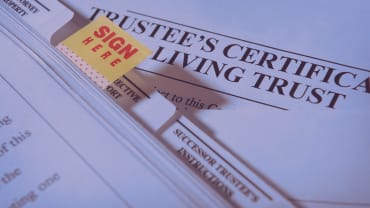The second of our short series of blogs discusses the long-awaited further expansion to HMRC's Trust Registration Service (TRS), which opened in Autumn 2021.
This expanded the TRS in two main ways: (1) trustees of all taxable trusts (or agents acting on their behalf) must update the TRS should any changes occur within the trust and also complete an annual declaration; and (2) the registration of non-taxable trusts was introduced.
I. Updates and annual declarations
The trust register requires every taxable trust to complete both the update and annual declarations process.
If any changes have been made to the trust (e.g., changes to trustees, settlor, beneficiaries, or anyone connected to the trust), these changes must be reported within 90 days of that change occurring. This must be completed in addition to the annual declarations process.
The annual declaration asks you to confirm whether any changes have been made to the trust in the previous tax year and, if so, these changes must be reported. It is crucial that, even if there have been no changes to the trust, the agent or trustees still need to "maintain" the trust and declare that there are no such changes.
As this introduction is relatively new, it is important to look back at the first registration as well as any subsequent declarations and make a note of the key information, noting any potential changes.
How do we complete this process?
Although an agent may have completed the initial registration for a trust on behalf of the trustees, this does not give them authorisation to complete subsequent updates to the register. A further authorisation process is required which requires one of the trustees to set up a Government Gateway ID for their trust (separate to any Government Gateway ID that that trustee may have in their personal capacity). Trustees will then use that Government Gateway ID for the Trust and "claim" the trust using that Government Gateway ID, using key information about the trust provided to the TRS during the initial registration process. Each trust must have its own Government Gateway ID, even if the trustees are the same on several different trusts (ie a series of family trusts for example).
Once "claimed", trustees can review the register, make any changes and complete the annual declarations.
II. Claiming a trust and authorising an agent to access the trust
If trustees would like an agent to view or make changes to a trust’s registration details, or complete the annual declaration, they will need to authorise the agent to manage the trust’s details on their behalf. In this case, the agent begins a "digital handshake" process and issues an authorisation link to the trustee holding the trust Government Gateway ID. Once that trustee completes the '"digital handshake", the agent will have access to the register and will be able to complete any updates and the declaration processes on behalf of the trustees in the future.
III. Non- taxable trusts
Until this expansion, non-taxable trusts did not need to be registered. Now non-taxable trusts (unless they meet one of the specified exemptions) must be registered by 1 September 2022 and this process is discussed further in our previous blog. A crucial difference to note is that non-taxable trusts do not need to be updated on an annual basis (at present).
IV. Important deadlines
A summary of key dates to be aware of:
- Changes made to any taxable trust must be reported to HMRC within 90 days of them occurring.
- Trustees (or an agent acting on their behalf) must declare the trust is up to date on an annual basis by 31 January after the tax year in question. Not only will penalties apply for late updates, but tax returns should not be submitted unless the trust has been maintained and updated. All annual updates for the tax year 2021/22 should be completed by 31 January 2023.
- All non-taxable trusts (unless exempt) must be registered by 1 September 2022, or within 90 days of the trust being created (whichever is later).
If you have any questions on the expansion of HMRC's Trust Register, or the requirements relating to your trust, please contact Claire Scott, or your usual Brodies contact. Click here to read part 1 in our series and here to read part 3.
Claire Scott is a key member of Hayley Robertson's team within the Personal & Family department at Brodies, providing services to individuals and families.











